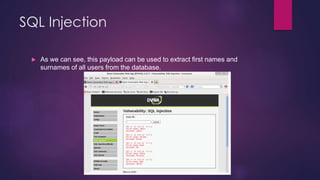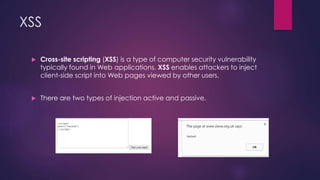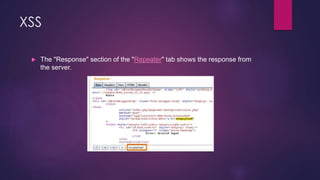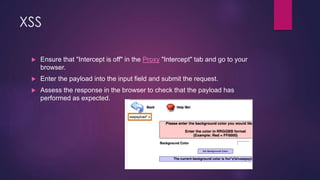Security Testing Training With Examples
- 1. Security Testing Training With Examples ALWIN JOSEPH THAYYIL
- 2. What is Security Testing • Security testing is the process that determines that confidential data stays confidential and users can perform only those tasks that they are authorized to perform. • It also helps in detecting all possible security risks in the system and help developers in fixing these problems through coding • Security testing is vital for e-commerce website that store sensitive customer information like credit cards.
- 3. Why web application security is of high importance • Web applications are increasing day by day • Most web applications are vulnerable. • 98 % of the web applications are vulnerable . • 78 % of easily exploitable weakness occur in web applications.
- 4. Types of web application vulnerabilities Security Testing is deemed successful when the below attributes of an application are intact • Authentication • Authorization • Client side attacks • Command Execution • Information Disclosure • Logical Attacks
- 5. Authentication – Stealing user account identities The Authentication section covers attacks that target a websites method of validating the identity of a user. To confirm that something or someone is authentic – true to the claims. The digital identity of a user is validated and verified. Brute Force attack automates a process of trial and error to guess a person’s username, password, credit-card number or cryptographic key. Insufficient Authentication permits an attacker to access sensitive content or functionality without proper authentication. Weak Password Recovery Validation permits an attacker to illegally obtain, change or recover another user’s password.
- 6. Authorization – illegal access to applications The Authorization section covers attacks that target a web sites method of determining if a user has the necessary permissions to perform a requested action. Is the Person allowed to do this operation Insufficient Session Expiration permits an attacker to reuse old session credentials or session IDs for authorization. Credential / Session Prediction is a method of hijacking or impersonating a user .
- 7. Client side attacks – illegal execution of foreign code • Content Spoofing tricks a user into believing that certain content appearing on a web site is legitimate and not from an external source. Cross-site Scripting (XSS) forces a web site to echo attacker-supplied executable code, which loads into a user’s browser.
- 8. Command Execution – hijacks control of web application SQL Injection constructs illegal SQL statements on a web site application from user-supplied input. Buffer Overflow occurs when a program or process tries to store more data in a buffer (temporary data storage area) than it was intended to hold.
- 9. Information Disclosure – shows sensitive data to attackers The Information Disclosure section covers attacks designed to acquire system specific information about a web site. Information leakage : Information Leakage is when a web site reveals sensitive data, such as developer comments or error messages, which may aid an attacker in exploiting the system. Path traversal : The Path Traversal attack technique forces access to files, directories, and commands that potentially reside outside the web document root directory.
- 10. Logical Attacks – interfere with application usage Abuse of Functionality uses a web site’s own features and functionality to consume, defraud, or circumvent access control mechanisms. Denial of Service (DoS) attacks prevent a web site from serving normal user activity.
- 11. Burp Suite Burp Suite is an integrated platform for performing security testing of web applications. The Burp Suite is made up of tools
- 12. Burp Suite Proxy: It operates as a man-in-the-middle between the end browser and the target web server, and allows the user to intercept, inspect and modify the raw traffic passing in both directions. Spider: Burp Spider is a tool for mapping web applications. Scanner: Burp Scanner is a tool for performing automated discovery of security vulnerabilities in web applications. Intruder: For performing powerful customized attacks to find and exploit unusual vulnerabilities. Repeater: Burp Repeater is a tool for manually modifying and reissuing individual HTTP requests, and analyzing their responses. Comparer: Burp Comparer is a simple tool for performing a comparison (a visual “diff”) between any two items of data. Limitations of tools: Unrealistic expectations from the tool & People depend on the tool a lot.
- 14. Brute force attack (Ex For Authentication vulnerabilities) • Brute Force Attack Brute Force Attack aims at being the simplest kind of method to gain access to a site: it tries usernames and passwords, over and over again, until it gets in. The most obvious way to block brute-force attacks is to simply lock out accounts after a defined number of incorrect password attempts.
- 15. Brute force attack (Ex For Authentication vulnerabilities) This is a web application having vulnerabilities. I am going to explain brute force attack with the help of burp suite.
- 16. Brute force attack Then send it to intruder
- 18. Brute force attack Then select the payloads and attack type.
- 19. Brute force attack Give the payload 1 datas. Here in this example I had given only some values actually you can upload username and password lists from outside.
- 20. Brute force attack Give the payload 2 datas and from intruder give the attack.
- 21. Brute force attack Check the request and response of payloads having maximum length variation
- 22. Brute force attack Now the brute force attack is successfully launched with the username admin and password password.
- 23. Password Passing to server( Ex for Information leakage ) • Password Passing to server The password should be encrypted while being transmitted over the network. In the below example password between server and client is being passed in clear text during the registration process.
- 24. Session Hijacking (Ex for Session Management) This test is to check whether the cookie can be reused in another computer during the log-in phase. 1. Login in the application and capture the request in that valid session along with the authenticated URL:
- 25. Session Hijacking (Ex for Session Management) Then copy it to a notepad
- 26. Session Hijacking (Ex for Session Management) • Open the new browser and go to the authenticated URL captured in step 1. Then, capture the request and replace the cookie with earlier captured cookie value:
- 27. Session Hijacking (Ex for Session Management) Successfully launched the session hijacking attack.
- 28. Directory Scanning (Ex for Authorization) This type of attacks exploits bugs in the web server to gain unauthorized access to files and folders that are not in the public domain. Once the attacker has gained access, they can download sensitive information, execute commands on the server or install malicious software. http://demo.guru99.com/Security/SEC_V1/index.php A small example for directory scanning can be shown from this site Here the login credentials are user id: 1303 and pass:Guru99. This is an ordinary customer login, having the rights to view his payments fund transfer etc. he is not having the permission to add, edit or delete other customers data. Enter the below url in the browser and check Now customer can add new customers. http://demo.guru99.com/Security/SEC_V1/customer/addcustomerpage.php I hope you checked it and understand how to perform it.
- 29. File uploads Only valid files should be permitted for uploading. http://demo.guru99.com/Security/SEC_V1/customer/contactus.php In the above link the upload file menu, currently accepts any file format including exe,php, js, etc. A malicious user can upload a virus or executable file and using The file size should also be checked so that users do not upload large files which would eat up the server space.
- 30. Forceful browsing A malicious user can access the complete application from different browsers without login. How to perform: Log in to an application then copy the url now paste it in another browser and check whether user is logging in or redirected to the login page. Recommendation: The application must implement proper session/cookie management on the server side, to ensure strict access control. This would avoid any user in directly copy-pasting of the link to get unauthorized access into the internal pages.
- 31. Audi trail Implementation An Audit trail should be incorporated in the application, where all user activities have to be logged.
- 32. Phishing attacks Phishing. It is a technique that uses trickery and deceit to obtain private data from users. A hacker may try to impersonate a genuine website such as yahoo and then ask the unsuspecting user to confirm their account name and password. This technique could also be used to get credit card information or any other valuable personal data. http://bank.83answers.com/ http://demo.guru99.com/Security/SEC_V1/index.php
- 33. SQL Injection SQL injection is a code injection technique in which malicious SQL statements are inserted into an entry field for execution. The targeted site to perform sql injection is dvwa
- 34. SQL Injection Enter User ID, click submit and intercept the request with Burp Suite Proxy. The next step is sending the request to Burp Suite Intruder (click right on the request and choose “Send to Intruder”).
- 35. SQL Injection A penetration tester can create his own list of payloads or use an existing one. Exemplary payloads can be found, for example, in Kali Linux (penetration testing distribution [4]) in the /usr/share/wfuzz/wordlist/Injections directory. Let’s use SQL.txt from this location to test the parameter id for SQL injection vulnerability.
- 36. SQL Injection It might suggest that more data was read from the database. Let’s check the response for this payload.
- 37. SQL Injection As we can see, this payload can be used to extract first names and surnames of all users from the database.
- 38. XSS Cross-site scripting (XSS) is a type of computer security vulnerability typically found in Web applications. XSS enables attackers to inject client-side script into Web pages viewed by other users. There are two types of injection active and passive.
- 39. XSS How to test XSS: Visit the page of the website you wish to test for XSS vulnerabilities Enter some appropriate input in to the web application and submit the request.
- 40. XSS Alternatively, return to the Proxy "Intercept" tab and right click on the request to bring up the context menu. Click "Send to Repeater".
- 41. XSS Go to the "Repeater" tab. Here we can input various XSS payloads in to the input field of a web application. We can test various inputs by editing the "Value" of the appropriate parameter in the "Raw" or "Params" tabs.
- 42. XSS The "Response" section of the "Repeater" tab shows the response from the server.
- 43. XSS Ensure that "Intercept is off" in the Proxy "Intercept" tab and go to your browser. Enter the payload into the input field and submit the request. Assess the response in the browser to check that the payload has performed as expected.
- 44. Dos attack A denial of service (DoS) attack is a malicious attempt to make a server or a network resource unavailable to users, Consider a functionality (such as registration) which typically does not require authentication. An attacker can easily place a heavy load on the server by simulate multiple registration operations and by feeding in arbitrarily huge input data through the registration fields, thus placing further load on the server and also consuming database connections. This could cause the server to crash or slow down to a crawl.
- 45. Other Security Checks • Session Time out • Session should terminate when user is gone through an error page • Auto fill should be off • Check whether application is able to view the authenticated page using back button of the browser • Check whether It is possible to view the contents of the authenticated pages by fetching the page from the browser cache memory and history. • User should not have the option to remember password as this may give unauthorized access to malicious users.
- 46. References https://www.owasp.org/index.php/ dvwa http://searchsecurity.techtarget.com/ http://demo.guru99.com/Security/SEC_V1/index.php
- 47. THANK YOU



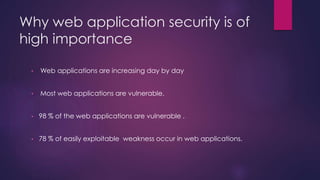
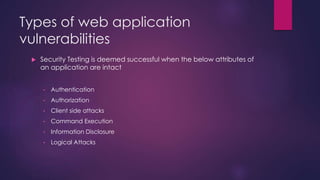
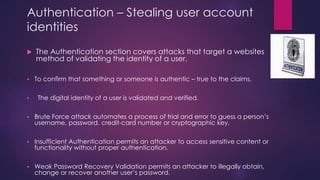

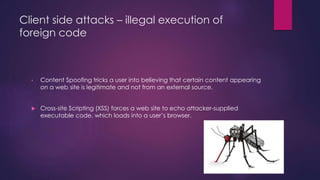

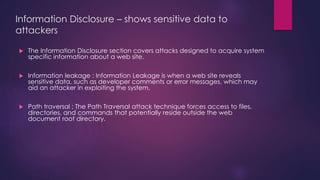

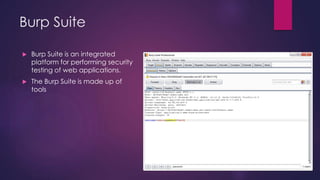


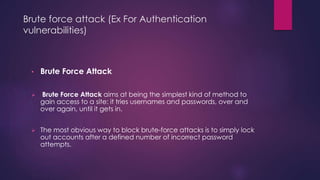



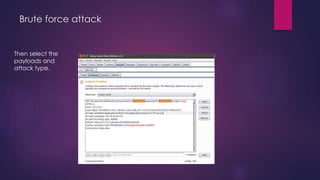
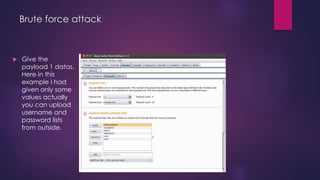
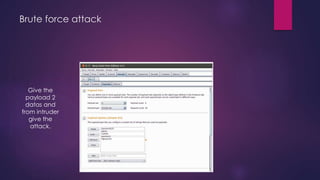


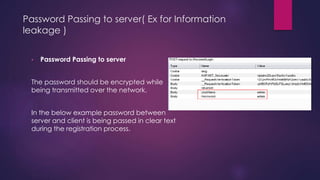




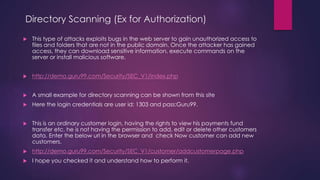

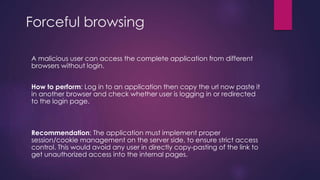

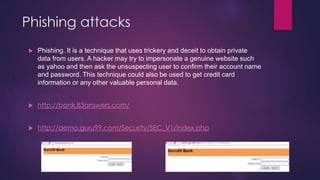

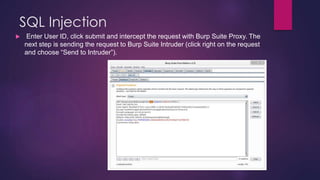
![SQL Injection
A penetration tester can create his own list of payloads or use an existing one.
Exemplary payloads can be found, for example, in Kali Linux (penetration
testing distribution [4]) in the /usr/share/wfuzz/wordlist/Injections directory. Let’s
use SQL.txt from this location to test the parameter id for SQL injection
vulnerability.](https://image.slidesharecdn.com/securitytestingtrainingwithexamples-150723093116-lva1-app6891/85/Security-Testing-Training-With-Examples-35-320.jpg)

